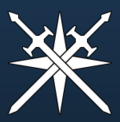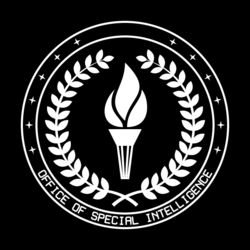Sign In
CloseGHF Manifest Section 4.03 - Command Hierarchy by victor-933

[4.03] Command Hierarchy
As already established, ForceCom functions as the supreme headquarters of all military endeavors. However, ForceCom alone does not perform full and thorough coordination of all military operations. Beginning with the Command Unification Plan of 2245 which established the modern StarForce and LandForce, top-level administrative functions for both branches were distributed among a system of Major Commands, abbreviated MACOMs. MACOMs are intrinsically linked with one another, as each MACOM oversees only a specific facet of military operation. Each MACOM is headed by a Force Operations Director of at least Grade IV. All MACOMs are based on Haedus Prime at Central Headquarters ForceCom.
MACOMs are primarily administrative in nature and each is tasked with the overall management of individual components of ForceCom operations. The largest MACOM is the Strategic Defense Command (STRATDEFCOM), which handles recruitment, training, operations, and equipment procurement of all combat units. Outside of military life, STRATDEFCOM's most well-known aspect is the Defense Acquisitions Commission, which works in close concert with the Federal Assembly to establish the military budget, and also proposes and requests new technologies and research. Another noteworthy MACOM is Special Weapons Command (SWEPCOM), whose responsibility is the storage, maintenance, and deployment of unconventional weaponry or weapons of mass destruction. Particularly devastating devices, such as nuclear weaponry or the HYPER-KP Cannon, cannot be deployed without express authorization directly from SWEPCOM.
The full list of current active MACOMs is as follows:
- Strategic Defense Command (STRATDEFCOM) -- concerned with recruitment, training, operations, and equipment procurement of combat units.
- Strategic Starlift Command (STRATLIFTCOM) -- charged with maintenance, construction, transportation, and logistical distribution.
- Strategic Intelligence Command (STRATINTELCOM) -- focused on military intelligence, espionage, and counter-espionage. STRATINTELCOM operates independently of SPECTRE and OSI, as its sole focus is military affairs.
- Tactical Operations Command (TACOPCOM) -- the military's unified Special Forces command, which trains and supports special operations units such as Hunters and Skyraiders under the umbrella of the Covert Operations Group (COG).
- Special Weapons Command (SWEPCOM) concerned with the storage, maintenance, and deployment of unconventional weaponry and weapons of mass destruction.
- Interstellar Cartography Command (INCARTCOM) -- catalogues interstellar phenomena in concert with civilian firms.
- Information Systems Command (INFOSYSCOM) -- deals with information storage and retrieval, as well as overseeing the operation and security of military communications networks.
Extraterrestrial Intelligence Command (EXINTELCOM) -- formed following the Extinction War to manage military response to alien contact pursuant to the articles of the Daybreak Protocol.
Military forces are additionally organized on a regional basis through a system of Unified Theater Commands, abbreviated UNITCOMs. Whereas the combined MACOMs act as a centralized administration system managing overall military operations, UNITCOMs focus on the actual deployment and military response needs of a given region, termed an Area of Responsibility. UNITCOMs are headed by a Force Operations Director III based at a regional headquarters within their Area of Responsibility, and all military units from both branches report to their attendant UNITCOM, who in turn is under the command of ForceCom itself. This makes UNITCOMs the highest level of regional command authority. Like MACOMs, UNITCOMs work in close concert with one another, in order to maintain a uniform combat-capable force across the entire Federation that can be deployed or repositioned at a moment's notice. This latter responsibility has taken special precedent in the years following the Extinction War, as overall military strength had been more than halved.
The full list of current active UNITCOMs is as follows:
- Unified Theater Command Northern (UNITCOMNORTH), whose Area of Responsibility includes the sectors Bright Sky, Northern Reaches, and The First Leap. Headquarters Unified Theater Command Northern (HQUNITCOMNORTH) is based on the planet Kadela in the Sedrim system, Northern Reaches sector.
- Unified Theater Command Central (UNITCOMCENT), whose Area of Responsibility includes the sectors Western Badlands, The Heartland, and Lisana's Bounty. Headquarters Unified Theater Command Central (HQUNITCOMCENT) is based on the planet Haedus Prime in the Damos system, The Heartland sector.
Unified Theater Command Southern (UNITCOMSOUTH), whose Area of Responsibility includes the sectors New Hope, Brimspark Wastelands, and Aurvak's Horn. Headquarters Unified Theater Command Southern (HQUNITCOMSOUTH) is based on the planet Evelance in the Shakoros system, New Hope sector.
ForceCom regulations allow for the activation and deactivation of additional UNITCOMs as needed. Assets and materiel of deactivated UNITCOMs is distributed between remaining UNITCOMs, or stored pending reactivation. Inactive UNITCOMS include:
Unified Theater Command Frontier (UNITCOMFRONT), deactivated in 2501 as part of the Command Revision Directive, following the loss of all assets within its AOR during the Extinction War. FRONTUNITCOM's AOR was composed of the sectors Hidden Garden, Southern Crossroads, Eastern Expanse and Southern Frontier. Headquarters Unified Theater Command Frontier (HQUNITCOMFRONT) was based on the planet Stonewall in the Kalrec's Chance system, Eastern Expanse sector until the planet's destruction in 2486, and was then relocated to Tolin's Respite for the remainder of the war.
Unified Theater Command Outer Reach (UNITCOMREACH), deactivated in 2501 as part of the Command Revision Directive launched in response to critical personnel shortages following the Extinction War. UNITCOMREACH's AOR was considered to be all territories outside of claimed Hadean territories, making it an expeditionary force. Headquarters Unified Theater Command Outer Reach (HQUNITCOMREACH) was based on the planet Altirran in the Union Bridge system, Western Badlands sector. With the dissolution of UNITCOMREACH, missions taking place beyond the Outer Reach are tasked instead to the nearest active UNITCOM.
In the current postwar era, military forces are distributed between UNITCOMs as follows:
UNITCOMNORTH: Third Fleet, Fourth Army
UNITCOMCENT: First Fleet, Seventh Fleet, Third Army, Home Guard
UNITCOMSOUTH: Fourth Fleet, First Army
The so-called Home Guard is composed of the Sixth, Seventh and Eight Armies. These Armies are composed entirely of Local Defense personnel, and even though they are considered under the jurisdiction of UNITCOMCENT their component units are distributed throughout the entire Federation, with other Armies assisting to fill in gaps as needed. Due to war casualties only the Eighth Army is currently active.
Subordinate to the combined authority of all MACOMs are the Numbered StarForce Fleets (NSFFs, abbreviated S#F, ex. S3F) and Numbered LandForce Armies (NLFAs, abbreviated L#A, ex. L5A). As of 2520, there are four active NSFFs, and four active NLFAs -- down from a previous seven NSFFs and eight NLFAs. This is due to crippling losses suffered during the course of the Extinction War.
Of the original seven Fleets, only the First, Third, Fourth, and Seventh Fleets are operational. Each NSFF is commanded by a single Fleet Commandant of Grade III or higher. NSFFs vary in size, however doctrine calls for the establishment of between five and ten Taskgroups per Fleet, and until these requirements are met the Fleet is considered Dormant. Each Taskgroup is composed of a Command Carrier and all escorts and support starcraft as well as the necessary equipment and personnel for continued operations, and is under the command of a Taskgroup Director of Grade III or higher. In general, a single Taskgroup is assigned its own mission, however the circumstances of the Extinction War necessitated the unified deployment of entire Fleets. A Taskgroup is abbreviated by a number appended to the shorthand nomenclature of its attendant fleet, for example S3F6 for Third Fleet, Sixth Taskgroup. When written out in full, numerals are never used. Currently, the largest operational Fleet is the Third Fleet, composed of eight Taskgroups and numbering 156 starcraft in total.
Taskgroups are further subdivided into Elements, each overseen by an Element Commandant of Grade III or higher. Doctrine prevents an Element from containing fewer than five starcraft, making them StarForce's smallest operational unit. Two additional command subdivisions, Squadrons and Wings, exists solely for the coordination of Strikecraft. A Wing contains five Squadrons led by a Sky Warden, while a Squadron contains five Strikecraft and their pilots, and is led by a Flight Marshal of Grade III or higher. Subservient ranks exist, namely Specialist and Cadet, however these typically serve to improve command and control capabilities aboard individual starcraft.Like StarForce, LandForce experienced significant losses during the Extinction War, with four whole NLFAs reduced beyond combat effectiveness. As of 2520 these NFLAs are still non-operational. Active NLFAs include the First, Third, Fourth, and Eighth Armies. Of these, only the First and Third are at full operational capacity.
NFLAs are each led by a Commander of Grade III or higher. Similarly to StarForce Taskgroups, Armies are split into four Divisions, each typically numbering 5,000 individuals and their equipment and headed by a Coordinator of Grade III or higher. Army Divisions use the same shorthand nomenclature as StarForce Fleets, for example L7A1 for Seventh Army, First Division.
Divisions are further broken down into ten Battalions, each holding 500 personnel under the command of a Field Commandant of Grade III or higher. From here they are further subdivided into Companies of 100 personnel each (led by a Field Warden of Grade III or higher), then Platoons of 50 each (led by a Field Marshal of Grade III or higher), Lances of 10 personnel each (led by a Lancecaptain of Grade III or higher) and finally Fireteams of between two and five troops. Lances only subdivide into Fireteams when engaging an active hostile force.
A typical Lance consists of one Dronemaster, one Linesuit, and eight Infantry. During the Extinction War, Lances were temporarily consolidated into units of 20 with two Dronemasters, four Linesuits and fourteen Infantry, in order to better coordinate and concentrate firepower and defensive efforts.
The Hadean species is defined by a large encyclopedic collection of writings that I collectively refer to as a Manifest. I also have Manifests for the Val'Turri species and am working on a new one for the separatist Hadean faction, the Outer Rim Concordat.
However, Hadean canon is constantly changing and evolving as I learn more and make more decisions, and the GHF Manifest itself is far from completion. Therefore I have been hesitant to reveal much of it except to close friends.
But here, have a taste.
Submission Information
- Views:
- 530
- Comments:
- 0
- Favorites:
- 0
- Rating:
- General
- Category:
- Literary / Other



